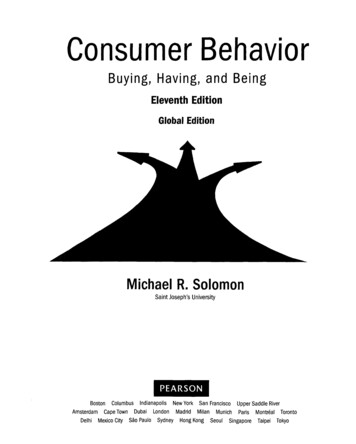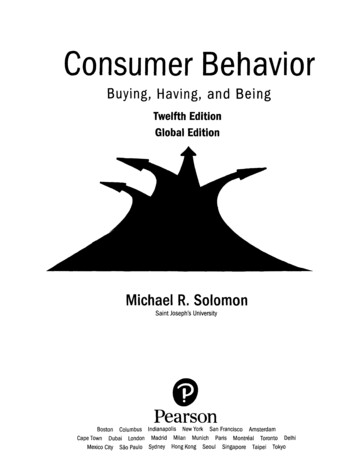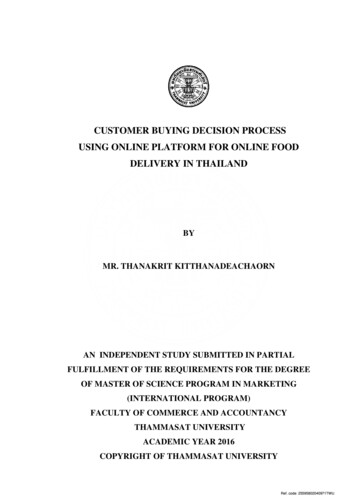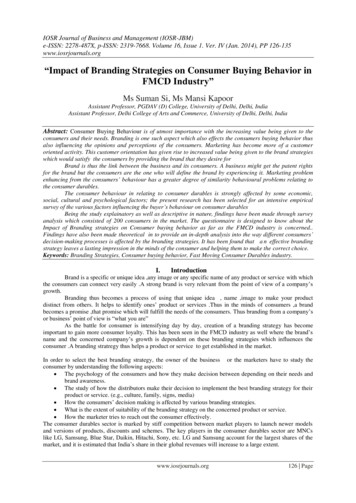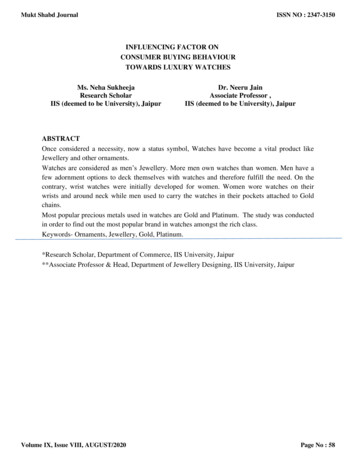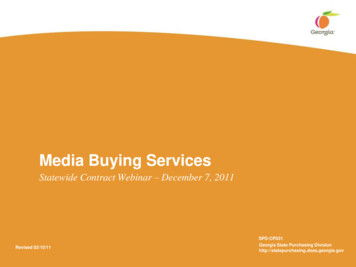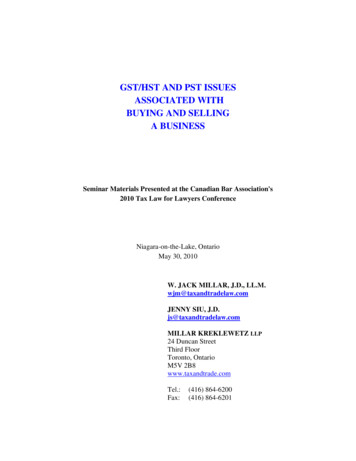
Transcription
Workforce Management:What Is It? Do You Need It?Rebecca WiseAbstractIn order to meet the objectives of Workforce Management of havingthe right people in place at the right time, contact center managersmust make calculations based on a number of factors. Among thesefactors are call volume, average call handle time, call distributionpatterns by intervals and agent off-line requirements. Managersshould work to avoid agent shortages or surpluses, and calls andagents must be managed on a daily basis to meet the actualdemands of the day. While it is possible to handle some of thesetasks manually, for most operations an automated workforcemanagement system is required.IEX Corporation2425 North Central Expressway,Richardson, Texas, Suite 500, 75080Phone: 1 972 301 1300Toll Free 1 800 433 7692www.iex.com
Workforce Management: What Is It? Do You Need It?What is Workforce Management?Workforce Management can be defined as having the right people in place to perform the rightactivities at the right time.This concept can be applied to any business that involves customers waiting for services. Whetheryou’re scheduling tellers at a bank or cashiers at a grocery store, using the principles of WorkforceManagement prepares you to meet your customer’s needs at every hour of every day.Implementing the principles of effective Workforce Management in a contact center is not alwayseasy, even in the best organization. Employees in today’s contact centers are often responsible formany other tasks in addition to answering incoming calls. However, if the events of the day are notproperly planned and managed, an entire day’s productivity can be lost to putting out fires. WorkforceManagement allows your company to be proactive instead of reactive.Let’s get acquainted with the fundamental principles of Workforce Management.Principle #1: Forecast to develop accurate call volume requirements.Luckily for those of us in call centers, history is a good indicator of the future. Historical information,such as the number of calls received each day, and the average time it takes to handle each call, isthe fundamental basis of Workforce Management forecasting. However, because we need accurateCall Volume Requirements and not simply the total number of calls on a given day, the distributionpattern of calls needs to be considered.During the week, every day receives a percentage (or distribution) of the total call volume. Dividingeach day’s call volume by total calls for the week gives you a Distribution Percentage for that day.When analyzing call volumes over a period of time, the Distribution Percentage makes it easy to seesimilarities in the way calls are distributed from week to week. Trends and patterns become evidentas you analyze weekly Call Volume Distribution during the month, or monthly Call VolumesDistribution during the year. Being aware of the Distribution Percentage (daily, weekly, and monthly)is a key element to accurately forecasting call volumes.External events can cause your Forecast Call Volume to increase or decrease, including events thatare currently unknown. Some events, such as holidays, affect call volumes for everyone and applywhether your business is open or closed. But other events are industry specific. For example, stockmarket activity can impact call centers in the financial industry.If the Call Volume you received in the past is not typical, eliminate that particular period from theforecast to keep your data pure. Let’s assume you used the most recent 13 weeks of history todevelop your Call Volume Forecast. If Monday is usually your highest call volume day and your datacontains a Monday holiday, including a day with zero call volumes in your calculations would loweryour forecast unrealistically. The same holds true if call volumes are higher than normal the day aftera holiday. You should plan future events by adjusting your historical forecast, but how much dependson the type of event and how it impacted call volumes in the past.Unplanned events, such as sick time and unscheduled Off-Line time, are just as critical to your CallVolume Forecast as events you do know about. Don’t forecast too tightly. Add a percentage ofSchedule Overhead to increase your Agent Requirements and help better prepare for the unknownand inevitable events of the day. If you’re not sure how much to add, 10 percent is a good place tostart.Copyright 2004 IEX CorporationAll rights reserved. IEX and TotalVieware registered trademarks of IEX corporation.1
Workforce Management: What Is It? Do You Need It?Average Handle Time is the length of time an employee needs to answer an in-coming call andcomplete any required administrative tasks. Like call volumes, Average Handle Times have a uniquedaily distribution. One of the factors that can influence Average Handle Time is an agent’s experiencelevel. If you scheduled experienced agents in the morning and trainees in the afternoon, you maynotice shorter Average Handle Times early in the day and longer times when less experienced agentsare scheduled.Daily Agent Requirement (sometimes called Daily Call Volume Requirement or Daily StaffingRequirement) is the number of employees needed to be available (or On-Line) to take calls. Youdetermine the Daily Agent Requirement as follows:1. Multiply the Number of Calls forecast for your Daily Operating Hours by the Average Handle Time(in minutes or seconds). This is the Work Volume.2. Divide the Work Volume by total number of minutes in your Daily Operating Hours and round theanswer. It’s tough to schedule 1/2 a person.If you use minutes for Average Handle Time, then be consistent and use minutes for Daily OperatingHours. The equation now looks like this:Number of Calls x Average Handle Time / Daily Operating Hours (in minutes) Daily Agent RequirementLet’s Do an ExampleYour call center operates Monday to Saturday, from 8:00 am to 5:00 PM. You expect 10,000 calls thisweek, with a Distribution Percentage on Monday of 20%, or 2,000 calls.Your Average Handle Time is 6 minutes, so the Daily Agent Requirement would be: Monday 2,000calls x 6 minutes / 480 minutes per day 25 AgentsThis calculation gives you the average number of Full Time Equivalent (FTE) agents needed onMonday. For each day of the week, you’ll want to calculate the number of people you’ll need. Tomake it easier to calculate, organize a worksheet with the days of the week in a column:Operating Hours(480 aily WorksheetForecast Call VolumesAverage Handle y AgentRequirement252018222515Are we finished? Not yet!Knowing just the Daily Agent Requirement, however, is not enough to help you schedule effectively.In the same way that weekly, monthly, and annual call volumes have distribution patterns, callCopyright 2004 IEX CorporationAll rights reserved. IEX and TotalVieware registered trademarks of IEX corporation.2
Workforce Management: What Is It? Do You Need It?volumes each day are distributed among Requirement Intervals, or periods during the day. If yougraphed daily call volumes by Interval, you would see a curve with peaks representing Intervals withhigh call volumes, and valleys representing Intervals with low call volume. To schedule your agentsefficiently within a day, you must know the Agent Requirement for each Interval. The shorter theInterval, the more accurate your Interval Agent Requirement will be. Most call centers use an Intervalof 15 or 30 minutes for their forecasts. Yes, it does increase the number of calculations but it’s worththe effort!Where can you get historical data in Intervals of 15 or 30 minutes to prepare a Call Volume Forecast?Most Automatic Call Distributors (ACDs) will collect call volume statistics for these time periods andprint reports to help prepare a forecast. If you do not have an ACD in your call center you’ll needmanual procedures to collect call volumes.Interval Agent Requirements can be calculated for every Interval of the day using the same formulawe used in the previous example:Number of Calls x AHT / Requirement Interval (in seconds) Interval Agent RequirementAdd a new column to your Daily Worksheet to list the Intervals for each day, and use this formula tocalculate the Interval Agent Requirement for every Interval. We use seconds to measure theRequirement Interval and Average Handle Time, and we’ll vary AHT for each Interval:Monday.SaturdayInterval WorksheetRequirement IntervalForecast Call(1,800 :30-5:00115Average HandleTime(sec.)360330390.420Interval AgentRequirement202322.27We’ve accomplished a lot with Principle #1. Not only have we forecast our call volumes, but we’vedetermined how many people are needed each day. More specifically, we identified how many agentswould be needed On-Line for each Interval during the day. Our next step is to see how we can bestmatch these requirements with current staff.Principal #2: Schedule agents efficiently to meet not only call volume requirements, but OffLine requirements as well.Let’s go back to our original example and see what happens when we schedule to meet AgentRequirements. This call center operates Monday to Saturday and employs 25 full-time agents. Duringthe week, 3 agents were given vacation days. How would we determine the number of agents toschedule each day? Let’s take it one step at a time:1. Multiply the Number of Agents (total 25) times their normal working schedule (5 days per week).Then subtract the number of Days Not Available (the 3 days that you granted for vacations). Thisis the total Available Work Days you can schedule:Number of Agents x Work Days per Week - Days Not Available Available Work DaysCopyright 2004 IEX CorporationAll rights reserved. IEX and TotalVieware registered trademarks of IEX corporation.3
Workforce Management: What Is It? Do You Need It?2. List the number of agents that are not available for each day in a column titled “Days NotAvailable.” In this example, it would be the 3 agents that were granted vacation days.3. Multiply Available Work Days by the Distribution Percentage for each day and enter the answer ina column titled “Daily Agent Availability – Calculated.” This is a guide to assist you in determininghow many agents to schedule each day.4. Look at the “Daily Agent Availability - Calculated” and round to the nearest whole number. Whenyou make your adjustments, remember to look at the column titled “Days Not Available” to ensureyou don’t schedule more agents than are actually available. The total Daily Agent Availabilityshould balance to the total Available Work Days.5. Subtract the Daily Agent Requirement from Daily Agent Availability. This will show whether youhave a Surplus or Shortage of agents each day.Let’s organize a worksheet for our example and do the calculations:25 Agents x 5 Days per Week - 3 Days Not Available 122 Available Work DaysYour Daily Worksheet should now look like this:Daily WorksheetDistributionPercentageDays NotAvailableDaily %111324.4019.5217.5821.4724.4014.64Daily 15125(1)(1)(1)(3)5731025Adjusted 24 20 18 21 24 15122Using this worksheet helps to analyze several things. First, it allows us to see where a Surplus orShortage falls during the week so we can do advance planning. Analyzing this call center, you cansee that temporary help or overtime may be needed on Monday, Thursday, and Friday. If you saw aSurplus you could schedule training, team meetings, or allow additional vacation days.This worksheet also helps in determining whether additional staff need to be hired. Fore example, thiscall center needs more staff since it does not have enough to accommodate vacations, meetings ortraining. It also shows you how many Days Off are available each day. In our example, Days Off arenot available on Mondays and Fridays.The Daily Worksheet illustrates how well current staffing levels meet Daily Agent Requirements. Now,using the Interval Worksheet, let’s see how current Agent Schedules match Interval AgentRequirements.Next to the column titled Agent Requirement in your Interval Worksheet create an Agent ScheduledLine. For each Interval, indicate the total number of agents you currently have scheduled On-LineCopyright 2004 IEX CorporationAll rights reserved. IEX and TotalVieware registered trademarks of IEX corporation.4
Workforce Management: What Is It? Do You Need It?taking calls. Make sure this number does not include Off-Line activities such as breaks and lunches.Subtract your Schedule Line from your Requirements Line. The difference is your Agent Net Line.Your Interval Worksheet should now look like this:Interval(1,800 -5:00ForecastCallVolumes100125150.115Interval gentNetLine52(3).(2)The most efficient schedule would show zero in the Net Line for every Interval. However, the degreein which you can match the Requirement Line to your Scheduled Line is often restricted by call centerwork rules. The tighter your work rules, the less flexibility you have in scheduling to meet the CallVolume Requirements of the day.Call center work rules, such as standard schedule lengths, fixed or limited start time windows, andfixed breaks and lunches make it almost impossible to achieve a zero Net Line. Even in the mostflexible of environments, a Net Line with no surpluses and no shortage is virtually unattainable. But,regardless how varied your Net Line may be, there are things you can do while developing schedulesto increase efficiency. Surplus in the Net Line is just as bad as a shortage.If your call volume is seasonal but your employees are not, you may have entire days or even weekswhen your Net Line shows a surplus. Finding ways to maximize productivity is crucial all year long. Ifyou do not have the luxury of simply sending agents home, you must incorporate Off-Line Activitiesinto your schedule where surpluses exist.Off-Line Activity is any activity where agents are not scheduled to take incoming calls. Some are assimple as breaks, lunches, and team meetings. Other, more complex activities are able to reap hugeproductivity increases, such as making collection calls, or job sharing with other departments. Thetype of Off-Line activities you can include in your schedules depends upon your business. The mainthing to remember is that a little bit of creativity can not only result in productivity benefits for yourcorporation, but in opportunity benefits for your agents as well.To reduce shortage in your Net Line you must be flexible.Fixed start times, lunches and breaks may delight your agents, but if they don’t answer customer’scalls your agents will quickly lose their delight when your business closes its doors. Fixed schedules,when they are placed correctly, can work in environments where call volumes are predictable. If theyare not suited for your call center, you will quickly see the inefficiency of fixed schedules in your NetLine.Major gains in efficiency can be made by allowing scheduled start times to be placed where they aremost needed each day. However, if the needs of your agents do not allow for this flexibility, evenmaking small changes such as incorporating flexible break and lunch times can make a difference.Copyright 2004 IEX CorporationAll rights reserved. IEX and TotalVieware registered trademarks of IEX corporation.5
Workforce Management: What Is It? Do You Need It?The more experience you gain in scheduling, the more you’ll see that balancing the needs of yourcustomers with the needs of your agents is truly an art.Principle #3: Manage calls and agents to meet the actual demands of the day.The day has arrived. Forecast Call Volumes look great, your agents are scheduled, and your Net Lineis looking tight. You’ve done a lot work and now you can sit back, kick up your feet and relax, right?Wrong!Up until this point, you have been in the planning stages of Workforce Management. As JohnSteinbeck once wrote, “The best laid plans of mice and men oft fall astray.” After all your painstakingpreparation, don’t make the mistake of failing to manage your workforce to meet the real-timedemands of the day.Schedules, no matter how necessary, are nothing more than snapshots in time. It is almost certainthat before you finish distributing them to your agents some will need to change. Forecast CallVolumes may also need to be adjusted to reflect the most recent call trends. In order to incorporatethese inevitable changes, you need processes for Interim and Intraday changes.Interim processes are changes to the Forecast or Schedules after it has been distributed, but prior tothe actual day it is used. An example of Interim Schedule Changes would be updating the ScheduledLine because an agent went on disability or transferred to another department.Intraday processes are also changes and updates, except they take place once the day has arrived.For example, an agent calling in sick or a supervisor requesting a last minute meeting.In either case, updating the Scheduled Line is critical. If the Scheduled Line is inaccurate, the NetLine will be as well. You may think you have enough agents On-Line, when you actually have ashortage.Interim and Intraday forecast changes are sometimes needed to incorporate the current Call Volumetrends. Updates in Interval Call Volumes will also require changes to your Requirement Lines so thatyou can see the impact on the Net Lines.When making changes to your Forecast, do not forget about the distribution of weekly call volume.Just because actual calls came in 15% above the forecast on Monday, does not necessarily meanthat Tuesday will increase by 15%. However, if you notice this trend for several days in a row, youmay want to increase your Forecast for the remaining days of the week.It’s just as important to pay attention to the Forecast deviation for each interval. By not monitoring thisclosely, you may have a knee- jerk reaction to a spike in calls that lasted only an hour. Goodworkforce management decisions are based not only on your ability to be reactive, by moreimportantly on your ability to be proactive.The Bottom LineIf you are in the business of taking calls from customers who are not willing to hold forever, and youhave limited resources, you need workforce management in your corporation. Can these principles beaccomplished manually? It depends entirely on your organization’s size and structure. If you have aCopyright 2004 IEX CorporationAll rights reserved. IEX and TotalVieware registered trademarks of IEX corporation.6
Workforce Management: What Is It? Do You Need It?single site call center and a manageable number of agents, you could even use pencils and a legalpad!However, as your business expands to multiple locations, or as you start to optimize operations, thetask may become so complex that it doesn’t appear to be worth the effort. This is where anautomated Workforce Management system would help you deploy these principles with much lesstime and effort. But no matter how you go about incorporating the principles of WorkforceManagement, it is worth the effort.About the Author:Rebecca Wise began her career in workforce management in 1990 at AT&T Universal Card Services,where she participated in the selection and implementation of the TotalView system. In 1995Rebecca joined IEX and held positions in both training and international sales support until she took asenior management position with the Convergys Corporation in 2000. Rebecca supported a teamresponsible for providing forecasting, scheduling and intra-day management services for the technicalsupport services division of Convergys until September of 2003 when she re
tasks manually, for most operations an automated workforce management system is required. IEX Corporation 2425 North Central Expressway, Richardson, Texas, Suite 500, 75080 Phone: 1 972 301 1





